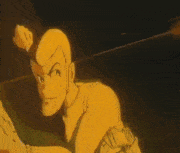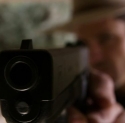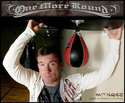|
kimbo305 posted:OP said getting killed instantly from the punch, as in the impact is enough to do that kind of unrecoverable damage to the brain. Not to take away from the horror of TBI and CTE beyond that, but itís just very Fist of the North Star that you could get the kind of damage youíd see from running a motorbike into a truck. The speed is not quite there, and the mass definitely isnít. Right, yes the instant death from a punch won't be happening with most humans, I agree.
|
|
|
|

|
| # ? May 17, 2024 17:50 |
|
It's my impression that most 'punch deaths' comes from the victim hitting their heads on the ground. An ex-pro boxer friend of mine also stated that bareknuckle boxing would be safer (but bloodier), as you simply can't punch as hard without tape and gloves, without breaking your hands.
|
|
|
|
ImplicitAssembler posted:It's my impression that most 'punch deaths' comes from the victim hitting their heads on the ground. There is a bare-knuckle boxing professional promotion now, and I don't think that theory holds up in practice. Reality is that it's just more brutal with less talented and more financially desperate fighters who would be in mainstream promotions if they could for the purses.
|
|
|
|
Had a sobering reminder of the consequences being discussed here recently. Everyone was fine, but there was potential for something serious. Was practicing with someone in my age range, several more years of experience and a few ranks above me, but much smaller than me. It was a very good practice session, then I went for a body check after a strike to the head, and this person went down pretty hard five feet away. They got up after a few seconds and continued the session with no harm done, but it really made me stop and think - bringing the right energy to each session is not one-dimensional but is very serious, especially when you're someone who can create an inherently dangerous amount of momentum. I think I fell into the psychological trap of respecting someone's kendo, and wanting to try my hardest, and forgot more important things. Got another session with someone else in that same size range soon after and made the right adjustment I think. With a big enough size gap, you aren't learning anything by including the body check, so better off just running through, even if you have to sharply change direction. I have plenty of partners my size to work on the body check with. That, among other things, made me feel very sure that I'd rather compete in the open division for my rank than the dedicated women's division. I have a tournament coming up, and several people have suggested either division would be acceptable, but I don't want the issues of significant size difference on my mind in a tournament environment. I'm sure there are many trans women for whom the math is different - early transitioners or naturally small people for instance. I also deeply appreciate the choice to call it an open division, and the choice by some tall cis women to enter it.
|
|
|
|
Had a late 50s grandma join today. A real legit, tattooed up grandma that I get the feeling is sick of taking poo poo in her life. Her 6 year old grandson is in our littles program and she decided to take the plunge after seeing some other 40+ in our adult class. I had her all class. She was so nervous but did truly awesome. She got way further than I expected and she seemed to be very happy at the end of class. Actually got her through all 19 moves of the white belt pattern a few times. Shakey, sure, but did it. Better than I was in the first class. For sure. Absolute total respect for someone that does that. I don't care what anyone says, going through that door as a mature adult on your own accord, by yourself, takes guts.
|
|
|
|
Ohtori Akio posted:Was practicing with someone in my age range, several more years of experience and a few ranks above me, but much smaller than me. It was a very good practice session, then I went for a body check after a strike to the head, and this person went down pretty hard five feet away. They got up after a few seconds and continued the session with no harm done, but it really made me stop and think - bringing the right energy to each session is not one-dimensional but is very serious, especially when you're someone who can create an inherently dangerous amount of momentum. I think I fell into the psychological trap of respecting someone's kendo, and wanting to try my hardest, and forgot more important things. Does kendo competition have weight divisions? If no, at a certain (agreed upon) level of drilling, is it not fine to give them the harder body contact they might see in a major asymmetric size matchup? I recently stumbled into footage of an absolute division match between two women of very different size: https://www.instagram.com/p/CxBuKCvP1yE/ When I first saw it somewhere else, I thought the weight difference was maybe 30lbs (tbf, I couldn't tell how tall they both were, and thought they were both smaller), not 65. I don't see any confirmation, but the absolutely vile comments suggest the bigger woman is trans. It kinda sucks if this is the only competition a 200lb woman (who's clearly not nearly as experienced) can get locally, but as long as they're willing to get destroyed, I hope it helps scratch the competitive itch. I've recently started training Inner Mongolian Bokh. Mongolian wrestling comes from an extremely long cultural tradition of no weight classes. There is a certain minimum size threshold before you see people being successful, but like sumo, there's surprisiingly good undersized wrestlers who are very skillful and have a mild benefit of having a style that other wrestlers might not have encountered as much. The other very striking rule is the first throw wins, and no time limits on matches. That completely changes how much effort/workrate you point in. Instead of looking for opportunities to score or lightly trying to generate action, you really really have to decide when you go all in, whether you think have enough of a tactical advantage to score over their counters/defense. This also feeds back into training, where to be realistic to the competition format, you have to (on top of drills or exercises that do push the pace) practice in a format where there's no clock running, so you can fully pay attention to how you use up your energy. I'll comment more once I have some usable footage of sparring.
|
|
|
|
Competition is typically divided into rank categories plus age for the juniors, and then subdivided in some cases by sex. Not weight except implicitly. You're right that the body check is an integral part of kendo, as are size mismatches, but where I hosed up is that the right person to present that aspect in a controlled way is an instructor. And, to a certain extent, a body check (we call it tai atari, body attack) is not really pretty kendo. I should have brought my prettiest most straightforward game to a skill mismatch one way and size mismatch the other, not attempted to use a full competition menu. You touch on how issues of trans people in sport are a really present issue right now, and that weighs heavy on my mind. I'm an unfamiliar experience for the art's community and I really do not want to end up on Youtube or as a scary after-practice ghost story as an example of the dangers of letting the terrifying trans participate.
|
|
|
|
Ohtori Akio posted:Had a sobering reminder of the consequences being discussed here recently. Everyone was fine, but there was potential for something serious. This is my take and it's not universally shared: There's an over-emphasis on teaching tai-atari to beginners and not enough on when (not) to use it. This leads to larger people start relying on it, rather than the actual scoring techniques. I'm glad you made the adjustment. Female kendo, in general, tends to be a lot more technique focused and in general it would be very easy for someone with a male(-ish) physique to bounce them out of the shiai-jo. You also need to learn to moderate the force of your tai-atari. When you start practicing with people less experienced than you, you need to be able to still execute it in a way that doesn't discourage people wanting to practice with you.
|
|
|
|
kimbo305 posted:Does kendo competition have weight divisions? If no, at a certain (agreed upon) level of drilling, is it not fine to give them the harder body contact they might see in a major asymmetric size matchup? There's no weight divisions and in general, the more experienced you get, the less physique/strength matters. Tournaments are typical divided by age up to 16/18 and then rank. High school kids will be segregated by gender, if there's enough participants, adults will usually always be, although the top division is often open for women to enter. (If they have high enough rank). Team matches are usually mixed, but using your physique to physically dominate someone A: doesn't look good and B: will undoubtedly weight the judges opinions against you. There are also clauses for excessive force, although a lot of shinpans (judges) are too weak to enforce them. Tai-atari , as mentioned above, has to be done in connection with a genuine scoring attempt. At the same time, if you get two willing participants, who are both willingly engaging rough play, you can let it go further than normal, as long as it's within reason. Similar in regular practice within the dojo. With my nemesis-buddy, it can often be very rough (by kendo standards), but we both know, expect and enjoy that. But we also both have enough skill and control not to hurt each other. At the other end, we then have our 70-somthing 7-dan female teacher, who's maybe 100lbs and you just focus on performing good techniques instead. Doing the above, would probably send her to hospital.
|
|
|
|
ImplicitAssembler posted:You also need to learn to moderate the force of your tai-atari. When you start practicing with people less experienced than you, you need to be able to still execute it in a way that doesn't discourage people wanting to practice with you. I have a few practice partners with the mass, age, physique, and experience to safely tai-atari with me, who notice I don't shy from it then sometimes start drilling hiki-men* with me. I think next time that happens I'm going to try and make the tai-ataris a crisp half speed at least part of the time, to start getting ready for this next step you mention. I could stand to make them more textbook with the right tsuba and blade position anyways. *non kendo people: the elementary scoring technique that follows tai-atari, a backwards-moving strike to the head
|
|
|
|
Honestly, I don't think tai atari has to be particularly hard/rough going. Like Implicit said I also think it's overemphasised often for beginners and it's not that important for competitions. You will very often reach tsuba zeriai (a position where the two fighters are very close, almost like a clinch) without a real tai atari before. As a 60kg male I obviously have issues with it, but I don't feel like it effects my shiai (mostly just means I'm a bad partner when practicing hikiwaza). I haven't gotten hansoku (penalty) because of someone pushing me out of the ring in years, you quickly learn how to deal with that. Height is a bigger concern but not the end of the world.
|
|
|
|
My beginner Muay Thai class has had a substitute instructor for a while. He's really into training our teep kicks right now. My desk job hip flexors and IT band have been very cranky after class as a result. I've been most sore on the top outer part of my quad, between the IT band and the pelvic bone. Anyone got some good mobility exercises or routines to recommend?
|
|
|
|
Soylent Pudding posted:My beginner Muay Thai class has had a substitute instructor for a while. He's really into training our teep kicks right now. My desk job hip flexors and IT band have been very cranky after class as a result. I've been most sore on the top outer part of my quad, between the IT band and the pelvic bone. Anyone got some good mobility exercises or routines to recommend? Leg swings, both swinging forward and circling. https://www.youtube.com/watch?v=D-yhPx9INV4&t=564s By circling, I mean move your foot in a big circle as you swing your leg up. I usually start inside out (right leg goes to the left, circles back centered by the peak, and then out to the right on the way back donw) and then switch to outside in, but I don't think it matters. I try to incorporate the stepping and timing of the checking part of the wai kru https://www.youtube.com/watch?v=Ivy7JpEHbHE&t=128s Doing that instead of straight legged is an easier warmup phase if you need it.
|
|
|
|
I recently got introduced to Mongolian Bokh. Gonna write up a little about it here and follow up later with a video of me trying it out. Mongolian Bokh is a group of folk wrestling styles practiced by various Mongolian ethnic groups. The particular ruleset likely goes back for a couple thousand years, but the culture around it and why Mongolians still practice it so much is because Genghis Khan decided that it was a good way for the army to keep fit, motivated, and skilled. The "Three Manly Skills" were archery, horse riding, and wrestling, with the latter broadly the most popular in modern Mongolian culture. If it not for Genghis putting his stamp of approval on it, Bokh might not have the same diehard following. Ok, so what are the rules? Like many folk styles, a match ends when someone lands on the ground. It doesn't matter if both people fall; the loser is who falls first. One of the most fascinating things to me about Bokh is that there's no weight classes and no time limits. No weight classes! You could be matched up to any other competitor who shows up to the tournament, even if you're outweighed by 100lbs. If you're a light wrestler, not only do you have to deploy one set of tactics against people of your size and speed, but you have to have another game ready when you square off with a giant. No time limits is an even more alien concept to me. How do you decide how you expend energy when there's no points, only total victory off the first successful throw? There's so many different ways to speed up or slow down the match, to try to feel out your opponent and try to pick the right time and right tactic to throw all your energy into. You could compete indoors on a mat, but usually competitions happen outside, so you might have grass, you might have dirt, there might be some rocks, anything goes. It's at least usually warm in the summer, when tournaments are generally held. The rationale from tradition is that if you're a soldier, you don't get a choice whom you fight against or where you fight. You have to win no matter the conditions even if they're unfavorable to you. In Khalkh Bokh, the style of the Republic of Mongolia, a fall is when any part of your body above the knee touches the ground. You're allowed to grab or touch the legs with your arms and hands. In Inner Mongolian (the province of China) Bokh, you're not allowed to grab the legs, and a fall is any part of your body above the ankle touching the ground. In Khalkh Bokh, you wear a tight fitting silk or wool bolero-type jacket (jodog), briefs, and shoes.  Here, blue jacket has a grip on the jodog belt and another grip on the wide collar. In Inner Mongolian Bokh, you have a short sleeve jodog that's geometrically looser but much stiffer thanks to the leather construction.  The loose pants are afforded by the no hand attacks rule. Often, the leather jackets are studded, which helps with impacts into hard dirt, as the studs drive into the soil and provide a little more give.  Naadams are competition events that encompass all 3 Skills, but frequently focus on wrestling. In the summer, thereís a naadam held somewhere almost every day, so you can easily get all the competition experience you can handle, even if itís one loss at a time. Competition field sizes are powers of 2 -- 32 up to 1024 for the national level stuff. Large naadam tournaments aren't settled in one day, but can you imagine the uncertainty of no time limits, first score wins, facing 5, 6, 7, 8 people of whatever weight up to the final? A tournament winner gets some prize money and maybe animals, but also for prestigious enough naadams, a jangga, the ribboned necklace you see in the previous picture. Imagine showing up to the event and there's this many tournament winners, and you might draw one of them first round:  The general hardness of life on the steppes, the extreme reverence Mongolians keep for wrestling, and the specific competition format have produced a lot of Mongolian competitors in other wrestling sports. As long as they're skilled enough, competing in sports that are more flush with money can be a good career move for talented Mongolian wrestlers. There's Mongolian world champions in judo, freestyle, sambo, and sumo. For them, their indigenous art isn't something set to put on a pedestal (even if their society thinks very highly of Bokh specifically), but simply one of many proving grounds. They already have a ready to fight anyone mentality from Bokh which probably helps them adapt to other rulesets. On the flip side, the viability of competing in a sport that levels the playing field for your weight means that a lot of skill developed by lighter wrestlers is departing Bokh, leaving behind absolute units who tend to have a more simplistic power based game:     On a side note, the practice of using wrestling as part of developing and maintaining an army's fitness was adopted by the Manchus and refined into Qing Dynasty imperial army training systems. Similar Manchu wrestling styles become the direct ancestors of Chinese shuaijiao, which is frequently billed (intentionally or not) as an indigenous style. While folk wrestling styles certainly exist and use some of the same cultural precepts about what is considered a fall, shuaijiao (and its influence on sanshou) has direct lineage back to Mongolian wrestling. kimbo305 fucked around with this message at 19:42 on Nov 2, 2023 |
|
|
|
Thank you for that write up! Absolutely fascinating. Some of those pictures were phenomenal. The single portrait with the water mark of just this insanely beefy wrestler was my favorite.
|
|
|
|
Go on, tell him his outfit looks dumb. I dare you.
|
|
|
|
kimbo305 posted:I recently got introduced to Mongolian Bokh. Gonna write up a little about it here and follow up later with a video of me trying it out.
|
|
|
|
One more update from me and my Wing Chun journey. I've earned my fourth belt (10 being Black belt) after passing an exam, and I'm now an intermediate student, where things will not only get more technical, as well as getting into official sparring classes. I started in February at 242 lbs (5'8") and with 0 experience in fighting. I'm now under 200 pounds (Hovering ~196) and now i'm going to slug it out with others! Most fulfilling thing about this is how nice fellow students, new and old, were to me regarding the work I put into this, now that I've ascended in a significant way. It's very encouraging and rewarding to work and hone myself alongside others. In fact, when I took my test, someone who's in my grade, but is older and has experience in other arts (thus, I look up to) said I had powerful, 'WWE Style' takedowns when we tested our ground-based movements and leg-shoot takedowns for our belts. It surprises me how good people say I am at something, compared to how weak I think I am at something. But now I have a collection of novice belts to hang up, so that counts for something. Morter fucked around with this message at 23:02 on Nov 4, 2023 |
|
|
|
Congratulations!
|
|
|
|
Morter posted:One more update from me and my Wing Chun journey. I've earned my fourth belt (10 being Black belt) after passing an exam, and I'm now an intermediate student, where things will not only get more technical, as well as getting into official sparring classes. That's awesome, congrats! Also, I had no idea Wing Chun had ground techniques or takedowns.
|
|
|
|
10 Beers posted:That's awesome, congrats! Also, I had no idea Wing Chun had ground techniques or takedowns. I want to say that i in no way want to invite criticisms on or from specializations of any kind, but as someone who's learning this stuff, our Shaolin Wing Chun has applications and responses for almost any scenario--that is to say, general positioning regarding a 1v1 scrap, hence why it's sold as 'a complete system'. It's specialization is short range striking, but we as students are taught a little bit of everything that embody the concepts of our, for lack of a better term, philosophy. You probably won't see many WC people go for leg tackles, but any moderate student should have at least covered it, so we're not all 'uh, whaddo i do now!' about it. At least, I say this as a <1yr student for a specific school, not as a rep of any kind.
|
|
|
|
Morter posted:One more update from me and my Wing Chun journey. I've earned my fourth belt (10 being Black belt) after passing an exam, and I'm now an intermediate student, where things will not only get more technical, as well as getting into official sparring classes. Good on you for sticking to it! Congratulations!
|
|
|
|
Morter posted:I want to say that i in no way want to invite criticisms on or from specializations of any kind, but as someone who's learning this stuff, our Shaolin Wing Chun has applications and responses for almost any scenario--that is to say, general positioning regarding a 1v1 scrap, hence why it's sold as 'a complete system'. It's specialization is short range striking, but we as students are taught a little bit of everything that embody the concepts of our, for lack of a better term, philosophy. You probably won't see many WC people go for leg tackles, but any moderate student should have at least covered it, so we're not all 'uh, whaddo i do now!' about it. My experience with various traditional Chinese martial arts is that they donít all profess to be complete systems. As they are often taught, which is to say, with a large degree of separation in motivation and methodology from how they were initially developed, they wonít have moves that cover all domains. Some arts are fairly complete within the cultural context within which fighting happened in China. Meaning a fight is over when someone is thrown to the ground. Praying Mantis is a solid example. A casual viewing of some poorly informed demos might make you think itís a lot of weird feeble strikes coupled with fingers-our eye poke strikes. In reality, itís snapping movements and hook hands reflect origins in clinches and throws. Mantis has techniques for striking, bridging to the clinch, and throwing to the ground. It doesnít have extended techniques on the ground because that was never a consideration for where fighting could happen. When practiced alive, a lot of its technique is just nuance on top of things that would be familiar to anyone who grapples https://youtu.be/y-ibNDPG71s?si=Vaosk74LSdEm3uRw Wing Chun is somewhat exceptional in how profoundly it has spread in the western world. Maybe itís the marketing appeal of being where Bruce Lee started formal training. But thereís so many schools with conflicting philosophies and interpretations of applications for the forms that itís hard to say that any ratio WC practitioners from different lineages would agree on whether WC ďhas a moveĒ for a given situation, or what that move would be.
|
|
|
|
Count Roland posted:Go on, tell him his outfit looks dumb. I dare you. Looks like a character out of one of the old final fantasy games. This is a compliment
|
|
|
|
i've reached the point in kendo where the juniors think i'm cool. pure profit from here on out, until they run circles around me in like two years
|
|
|
|
Ok, some footage. I haven't done watched more than a couple times. I suspect at least to people who can't see the intricacies of weight shifting and relative positioning (which of coruse includes me), this might be like softball -- more fun to play than to watch. But nevertheless, it's footage I can at least provide some direct 1st person commentary on, unlike some of the highlights out there on Douyin. So this is my 2nd time ever doing Bokh -- much improved on my first outing but not saying much. Prior to this, I had done like a month of BJJ and a few months of judo. Not much of that translates over compared to my sanshou instincts, which lead to me keeping a narrow stance and carrying my own weight in clinches. In my first session, I noticed how much I defaulted to no-gi gripping concepts, namely underhooks and two-on-ones. I was aiming to do more jodog-specific grips in this session, with inconsistent success. To introduce who I'm wrestling with -- Vincent Tseng has a bit of a presence in the martial arts social media scene. He has a lot of traditional training methodology commentary as The Wandering Warrior. He went from a lot of shuaijiao training to getting more into Inner Mongolian Bokh. He was out in Inner Mongolia for a month this summer to really ramp up his game. Since he's Boston based like me, we eventually hung out in person, and I thought it would be cool to try Bokh out, as a complement to how I teach sanshou, which leans more to the striking side. At my current flabby weight, I'm almost 50lbs more than him. His goal is to get up another 10lbs of muscle, which is an empirical threshold for finding success in Inner Mongolian competition. As the weight difference sits, I'm trying to be smooth and not herky jerky into or out of anything, to maximize what I'm able to sense of the exchanges [the audio is really harsh from construction going on across the street] https://www.youtube.com/watch?v=qadMhiu9_nY&t=10s I'll call out all the moments of interest: - in true Bokh fashion, we're doing it outside. Vincent is wearing Inner Mongolian style gutal boots, and I'm in some rubbery Feiyues. Grip was pretty good on the grass, imo - throughout, I have a decent sense of where the camera is, and to a degree, I either move or allow myself to be moved to center the action a bit. I don't think it really put me at a disadvantage - 2:05, Vincent pushes forward into a leg reap combo. I'm pretty alert and hop out of the way. Upon recovering, I just dumbing push my right hand against his sleeve instead of trying to get any sort of grip. - 2:40, you see him subtly reeling me up and in for a trip, but again I'm too wary for it. I manage to reestablish grip on his belt and do a half-hearted outside sweep attempt (this is probably the sanshou throw I'm most experienced with that doesn't involve arm on leg contact; it's of course common to many arts), just completely bouncing off his well-rooted leg - 3:22, after going through a few grip configurations, he gets two grips to my one, and yanks me forward and then leans down on my shoulder. I'm able to stay upright, but having to squat to resist the pressure. So I'm very up and down posturally, though obviously keen that I'm getting set up. As I make space at 3:30, he pulls me back in and goes for an inside reap. I fight that off, try to heist him up with a bodylock, but fail and am standing straight up, so fall victim to the sustained pressure of the repeat reap - 4:15, you can see the lightness of my footwork that comes from striking. I'm not sitting down on my heels much. - 4:23, after getting pulled in again off of a horse's mouth grip on my right sleeve, I'm trying to get his hips close to mine. Starting againg from not trying to grip anything and just putting my hands anywhere, I go for the belt but have no feel for how to get under it, so switch to an easily broken gable grip, give up, eventually settle back to no-gi grips. - 4:46, Vincent goes for a deep far side leg trip, I try to throw his upper body away, he keeps backing up and I touch my knee to the ground - 6:14, good example of the slow buildup pace that Bokh can have. Vincent keeps steadily advancing, switches to an overhook and keeps my torso bent off to one side. The moment I try to reach across with my left leg to his rear foot, he's ready to stride across, block my knee, and pull me over. Tai otoshi in Judo? This throw goes slowly, but I'm in for the ride the whole time thanks to how rigidly I'm held by my jodog. - 8:28, Vincent starts an offensive sequence of leg trips. I manage to get out of the last one, but it's precarious. Again, when you're locked up on each others jodog's, the 2-body structure you achieve can balance on a very fine line between standing and falling. So even if things are moving slowly, it pays to fully invest in trying to keep budging and trying to get that topple. - 8:40, another fun leg attack sequence. I offer one counter in the middle, no good, and then get squashed down at my shoulder again. Try a sweep at 8:57 but am completely read and and countered - 9:39, I forget the rules and pop under his arm to go for a knee tap. Whoopsie - 10:52, I think I'm gonna try something by putting my foot behind his lead, maybe wrench him up and back. I'm overall too complacent with being in this 90deg foot stance, and Vincent sends me over his leg with what's called a wai in shuaijiao. And again, how slow it is doesn't how sure a thing the throw is. At every step of the way, I'm just behind enough that I can't recover out of the situation. - 13:45, I'm definitely flagging in energy at this point, and I think Vincent can sense it. Once we break grips on one side, he fakes reengaging on that side and switches to a 2-on-1, finishes with a shuaijiao jidao ("squash down"). If I were fresh I would have tried harder to hop around the blocking knee, but I'm just giving in at this point - 14:58, Vincent starts a creeping advance into a throw that only materializes 30s later, once he's got all the marbles on his side, then he commits Some other notes: - the jodog is supposed to be worn down under the shoulders, with the collar running across your shoulder blades, and the sleeves down at the crease of your elbows. Given how stiff the leather is, these are custom sized to your proportions - to really secure a grip, you're supposed to curl your fingers back up once you have gotten inside the sleeve. Obviously how feasible this is depends on how tight the sleeve is to the arm, how big your hand is, and how stiff the leather is. I would say it was pretty easy for Vincent to do to my training jodog with only canvas for the central span of material, but I was struggling with his stiffer jacket and my fingers not being used to it - if striking sports are described as games of millimeters, I'd call Bokh a game of seconds. Either you're literally passing time out there, doing true active resting by backing off / disengaging and just breathing, or you're putting everything you got into a single moment of full attack. In some footage I've seen, you see a pair of wrestlers going at it, and the nearby wrestlers do a gentleman's agreement to split apart to watch the action, in part because they could get bowled over if they don't get out of the way
|
|
|
|
So I'm having trouble with side kicks. That...horizontal split motion (for lack of a better term? Spreading your thighs outward) gives me a painful tweak if I do it too far, which is not very high--I can barely kick above belt level. Conversely, anything else i'm inflexible with, I just can't reach--straight or high front kicks I can do without a problem. I want to address this Besides the stretches that I do before training or after exercises, I was also considering (even before the flexibility issue, honestly) to pick up Tai Chi because, from what I've understood about reading about it, it will help with balance and flexibility especially in the legs. Does anyone have any experience practicing/learning Tai Chi to supplement what they were learning? Is it a good/bad idea? Should I wait for a certain amount of time or experience in what I'm doing before I consider a secondary art? What i'm studying now, Wing Chun, is the first art I'm ever picking up.
|
|
|
|
Sounds like you're better off spending time stretching rather than picking up another art.
|
|
|
|
E: My reply below was written when I read on my phone and didn't absorb your full question. I'm answering related to a, what I would call, side kick. I assume there might be some differences between arts (I know less than nothing about what you do) but probably a lot of commonality as body mechanics are going to be the same regardless as we're all humans. It is a fairly basic white belt technique for us, and I suspect similar for most, although, surprisingly can be difficult to do really well even though it seems basic. But, I also agree with ^^, don't try to do a bunch of everything. There are 2 common things that cause issue with poor form. 1: As with all kicks that end in a position similar to that and *not* facing the front, the most common issue is not rotating your supporting foot to allow your hips to open up. Ensure when you are finished, the toes on your supporting foot are pointing in the opposite direction then your kicks Primarily this is done so you lead with the heel of your foot, but also helps with everything else. Some flexible people (mostly children and young women) can do it with their toes pointed at roughly 90, but few grown men can do that and it will likely physically hurt if you try. If you're not sure if you're doing it, put your back flat against a wall and get yourself into the finished position and see where your supported toes are pointing. If your support foot isn't pointed the opposite way, pivot it so it is and see what it feels like. Another way to tell is if you're not leading with your heel on your kicking foot, you're almost certainly not in the right position on your supporting foot. The ball of the foot should not be the most forward. And also, in practice, leads to a far, far weaker kick. 2: You need to lower your head, bend at your waist. Similar as above, if you're super flexible, you might be able to get quite high without bending your upper body, but most grown men cannot do that, at least not well. There is more to it for sure, but these are the basics. If you don't have an instructor on hand for immediate feedback, it might help to get in the proper finish position and work backwards. ee: This is what I'm talking about. This kick is quite low, but you can tell the lower he brings his torso, the higher his kick is going to be. Also notice the supporting foot turned right around and the heel leading with the kicking foot. 
slidebite fucked around with this message at 14:25 on Nov 18, 2023 |
|
|
|
Morter posted:So I'm having trouble with side kicks. That...horizontal split motion (for lack of a better term? Spreading your thighs outward) gives me a painful tweak if I do it too far, which is not very high--I can barely kick above belt level. Conversely, anything else i'm inflexible with, I just can't reach--straight or high front kicks I can do without a problem. I want to address this quote:I was also considering (even before the flexibility issue, honestly) to pick up Tai Chi because, from what I've understood about reading about it, it will help with balance and flexibility especially in the legs. Yang style taijiquan is the most common style, in the US certainly. That's the stereotypical slow, steady movement style you see old people doing. The benefits I can think of training it as it pertains to kicking better and higher: - there are a handful of movements that are decent dynamic stretches with (thanks to the slowness) good eccentric loading. Depending on how you're taught, you might not actually get low enough* to really stretch out the legs - the slow movement can help with fine tuning your balance sense and developing the muscle control to actively keep yourself balanced *example illustration of a nice deep stance into a shifting into a single leg stand. IMO the most demanding sequence in taichi.  Doing taichi for kicks would be very inefficient. Martial arts, like most athletic endeavors, are pretty movement specific. You get the most from doing things that closely resemble what you want to do. Targeted dynamic stretches and practice kicking on a heavy bag would be a much faster, more direct route to good technique and better range of motion. The balance development you get from any Wing Chun live drills that include kicks would be just as effective for getting better at balancing in those postures. Semi-related -- one of my students asked me about some of the form details in this (pretty brutal) high side kick: https://www.instagram.com/reel/CuE0e9ANNOh/ I got into a big debate with myself about how to teach the nuance of how much to turn over the hip, tried to illustrate a sidekick, and got bogged down in not having enough detail in the drawings:  The high school physics breakdown is: - person throwing a non-hopping-forward sidekick is an inertial frame of reference - angular momentum is therefore conserved (at 0, since you're not rotating at constant speed). You start standing still, not rotating. You will end up not rotating (unless you're gumby and can twist infinitely at the waist). - every movement that applies an impulse (torque times duration) to your angular momentum must be canceled out by a net opposite impulse - when you chamber your kicking leg, the sum of your torso, head, and arms must cancel out that chambering. Because the torso is heavy, this generally works out to the torso rotating toward the leg, and the arms offering some extra fine counterweighting. That's what I was trying to illustrate with the paired orange arrows -- simultaneous mutually canceling out of impulses. You know this cancelation is pretty exact from fighters who can chamber that kick and stay still for even a moment -- they are recovering to a specific configuration of 0 angular momentum - when you kick, the thigh and lower leg shoot out in front, so the torso and arms needs to shift back to again cancel out that angular impulse. As you can see, the speed and power of your kick depends on how fast you're shifting your upper body around. This is inescapable. That's illustrated by the paired purple arrows (omitted some arrows cuz of poor organization of white space in my stick figure) - how much torque about your center of mass your kicking leg generates depends on how you time the unfolding of the knee and hip and how turned over your hip is. The smaller the torque, the less power you need to exert (from creating matching smaller counter torque with your upper body) for the same kind of impact Anyways, where I got stuck is advice on how much to turn the hip over. I think it depends on lot on how much you spring forward (which is an acceleration for the frame of reference and invalidates all the easy conservation above) and the relative timing of chambering your leg vs shifting the torso (which can be preloaded now by the springing). Springing forward a lot means you can chamber deeper (hip turning over more) and kick harder for the same amount of torso tilt-back, since some extra impulse is coming from that springing acceleration. Whether you need to depends on the tactical situation you're in. Development of single kicks is figuring out what your muscles can handle** and arranging their relative timing and force to pull the kicking leg one way, and the rest of the body the other way. Multiple kicks or combos with kicks become much wilder in terms of the possible phasing of the various angular impulses going on. Unfortunately, this is all theoretical and IMO can't really help you. It's mostly something that you can intuitively generalize after figuring out how to kick. **In slidebite's writeup, pointing the support foot back 180 or 135deg is what allows you to turn your hip over and to easily contract the muscles to tilt your torso back toward the support leg. If you kick awkwardly, you know something is up with your muscle and joint arrangement, but an instructor can tell right away by observing. To the extent that people are generally built the same way, they can give you the "do's" and have you feeling immediately more effective, and then you repeat a lot, forget parts of what you're supposed to do, get corrected, repeat a lot more, and then get a handle on it, and then start refining it on your own. gently caress it, one more sidekick video: https://www.instagram.com/p/CzfpPFgP6cu/ I don't generally approve of stepping the support foot up as the first part of the kick as it telegraphs more, but it's useful as it essentially tilts your torso back for free, which helps with aiming to the head as seen here by red. Red also masks the telegraph with a jab first. Red chambers the kick and turns over the hip faster, assisted by how the support leg's coming under the pelvis. The torso tilts forward, coiling up in time with the chambering leg, and then shifts back as the leg fires out. kimbo305 fucked around with this message at 07:13 on Nov 18, 2023 |
|
|
|
I cannot stress enough that yoga is one of the best compliments to any martial art or sport. It will very quickly identify the parts of your body that are weak and lack mobility, as well as helping develop thoughtful breathing techniques which are vital to maintaining your cardio in long training sessions and matches. It also makes you feel good. A second point is that often when someone describes themselves as 'inflexible', what's really happening is that a muscle is weak and imbalanced. A common example is hip flexors/hamstrings. People tend to focus on their hamstring flexibility but neglect strengthening their hip flexors which are necessary for basically any athletic motion.
|
|
|
|
I did a tiny bit of yoga (and some pilâtes) a few years back when I realised I'm very injury prone. I stopped for various reasons (mostly time, but I also found it excruciatingly boring so it was hard to be motivated). I considered trying something like that again but I feel like a focus on stretching is unhelpful, as most modern sports science says stretching/flexibility for injury prevention probably doesn't really work, and got strength I could work out the specific muscles I needed at home or at the gym. So other than the help of an instructor in finding and doing those exercises I didn't feel motivated in going back. Can you convince me otherwise (honestly asking)? I do kendo competitively (3-4 a week) and I usually get injured 2-3 times a year nowadays (I'm 31).
|
|
|
|
Stuff like kettlebells and isometrics might be what you're looking for? Pilates too. I agree on finding it kind of boring though. I used to do yoga with our MMA coach and I enjoyed his classes. He took that fighting coach outlook (in a good way) so he'd correct our details and we had progressions towards more challenging positions. I tried a class with a pure yoga teacher and it was similar; it was his class for the serious practitioners. so they were all 10x better than me but the focus and mentality was a fit. Versus the more casual offerings where people probably don't want to hear how they can improve. So, also maybe you can find a better fit in the yoga practice.
|
|
|
|
I also find a full yoga session to be a little too boring to do on a regular basis, but everyone should do *some* kind of structured stretching program (whether it's yoga or pilates or whatever) at least long enough to figure out which stretches are most useful for their particular hobbies and body. For example, I do pigeon pose and frog pose before every BJJ session because that kind of hip mobility is essential for playing open guard, but those two and shoulder dislocates are about the only ones I bother with unless I'm feeling especially tight that day. For people who don't want to go to a stretching class, Joe DeFranco's Simple 6 and Limber 11 are great routines 'cause they're pretty quick and simple, and they're mostly dynamic stretches.
|
|
|
|
Probably depends on the workout, but I've always just stretched afterwards. I have very casually seen mention of the studies that that is ok and just gone with it.
|
|
|
|
This is my favourite (not short) summation of the (in)effectivity of stretching in general. Your mileage may vary but I would definitely give this a read, or other general analyses of stretching: https://www.painscience.com/articles/stretching.php
|
|
|
|
kiminewt posted:I do kendo competitively (3-4 a week) and I usually get injured 2-3 times a year nowadays (I'm 31). That's still a very high amount of injuries and I would find a sports physio that can do a movement analysis instead.
|
|
|
|
Stretching has never done anything for me. I've gotten a lot of benefit from a few sessions with a PT/trainer to spot which of my movements were janky, then doing targeted strength work to fix those.
|
|
|
|
I apologize for asking a question that I'm sure has been asked a hundred times, but i couldn't find any relevant examples in the thread..so here it goes Which Martial Art Style Is Right For Me?  My main motivation is actual self defense (i am very much a conflict avoider and am pretty good at de-escalating and i don't intend to change any of that, but it would be nice to be at least a little more capable of holding my own if I ever get in an absolutely unavoidable attack), and aside from that, it sounds like an enjoyable fitness activity. I enjoy body movement. I'd prefer to avoid strikes/blows/anything punchy, and focus on evasion, blocking, throwing type stuff My body type is tall, lanky, fit but not especially strong, i climb and bike a lot No intent to compete, just wanna take a class for a while Given all that I just said, and knowing next to nothing about martial arts, my uninformed first guesses are aikido and BJJ, but again i know nothing Thanks for any thoughts y'all have  e: i already have running shoes 
alnilam fucked around with this message at 00:40 on Dec 1, 2023 |
|
|
|

|
| # ? May 17, 2024 17:50 |
|
BJJ or judo sound perfect for you. Climbing gives you great grip strength for those sports. Judo is usually a bit more serious and athletic, BJJ is usually more chill and hobbyist, but those things will vary from gym to gym. Check out what gyms are near you in those two arts and do trial classes at a whole bunch of them until you find a vibe you like.
|
|
|





























